Motivation Schemes to Enhance Employee Productivity in UK Retail Sector: A Study on Sainsbury
VerifiedAdded on 2023/06/14
|12
|4115
|331
AI Summary
This dissertation investigates the motivation schemes used by Sainsbury to enhance employee productivity in the UK retail sector. It explores the benefits of motivation schemes and the various techniques used to increase employee potential. The study uses qualitative research and thematic analysis to identify the most effective motivational schemes.
Contribute Materials
Your contribution can guide someone’s learning journey. Share your
documents today.
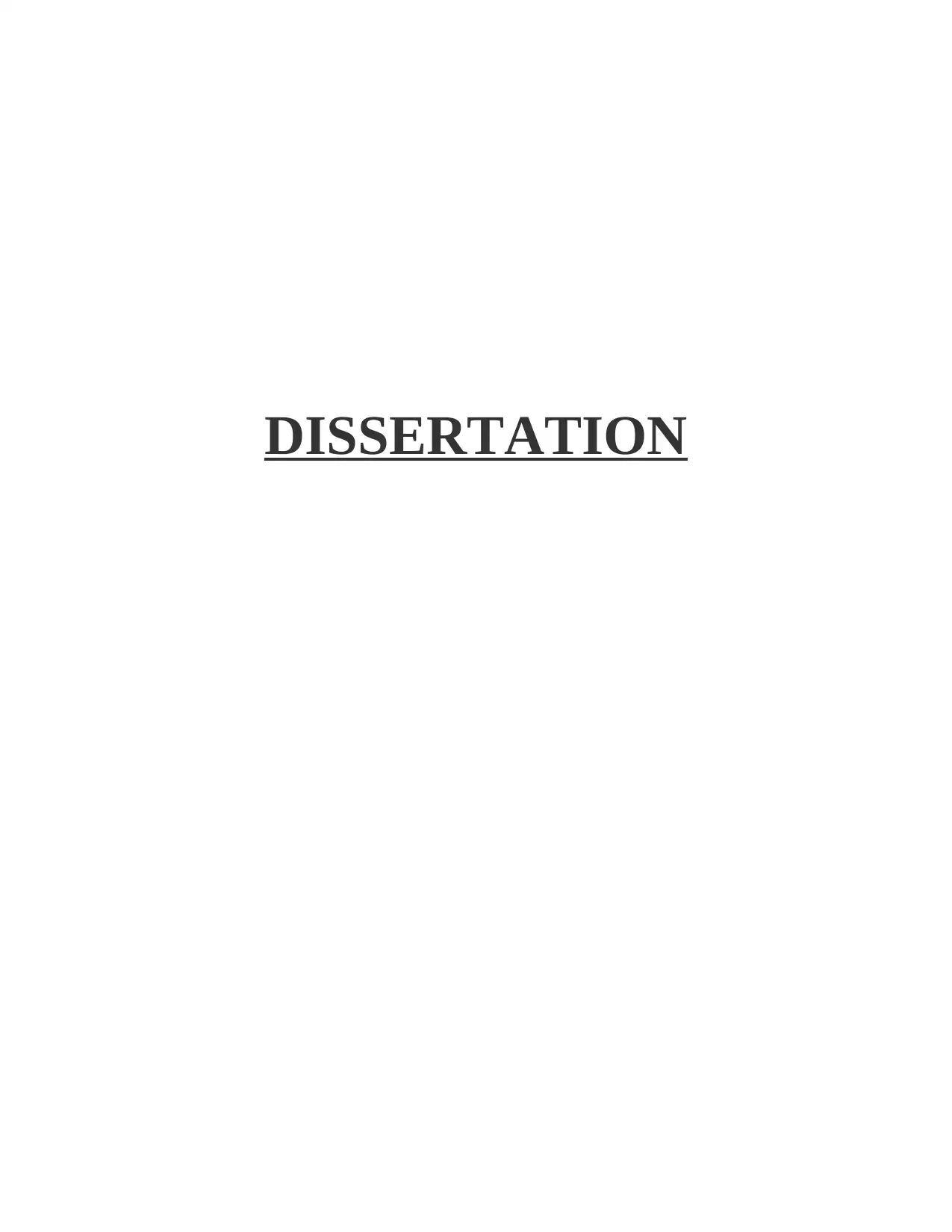
DISSERTATION
Secure Best Marks with AI Grader
Need help grading? Try our AI Grader for instant feedback on your assignments.
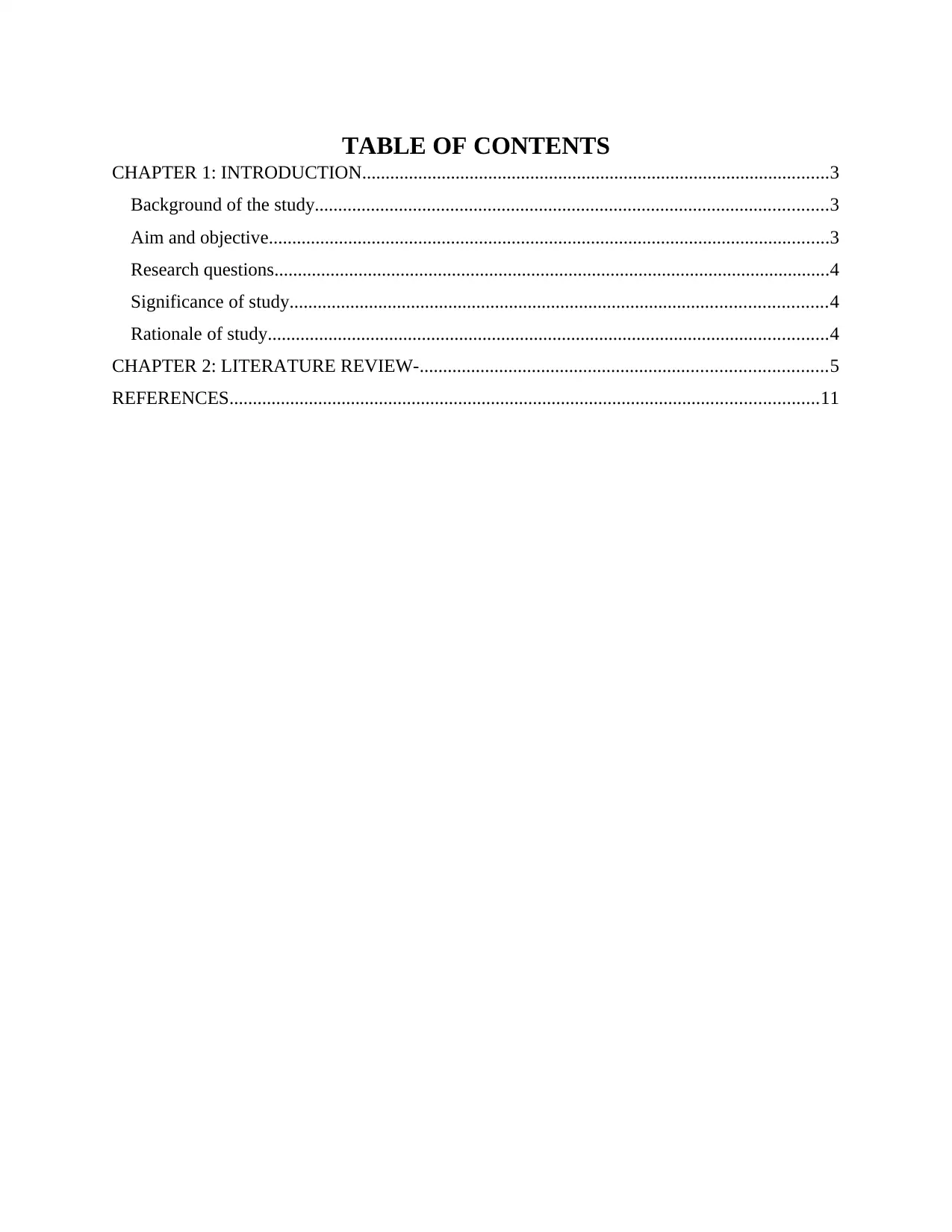
TABLE OF CONTENTS
CHAPTER 1: INTRODUCTION....................................................................................................3
Background of the study..............................................................................................................3
Aim and objective........................................................................................................................3
Research questions.......................................................................................................................4
Significance of study...................................................................................................................4
Rationale of study........................................................................................................................4
CHAPTER 2: LITERATURE REVIEW-.......................................................................................5
REFERENCES..............................................................................................................................11
CHAPTER 1: INTRODUCTION....................................................................................................3
Background of the study..............................................................................................................3
Aim and objective........................................................................................................................3
Research questions.......................................................................................................................4
Significance of study...................................................................................................................4
Rationale of study........................................................................................................................4
CHAPTER 2: LITERATURE REVIEW-.......................................................................................5
REFERENCES..............................................................................................................................11
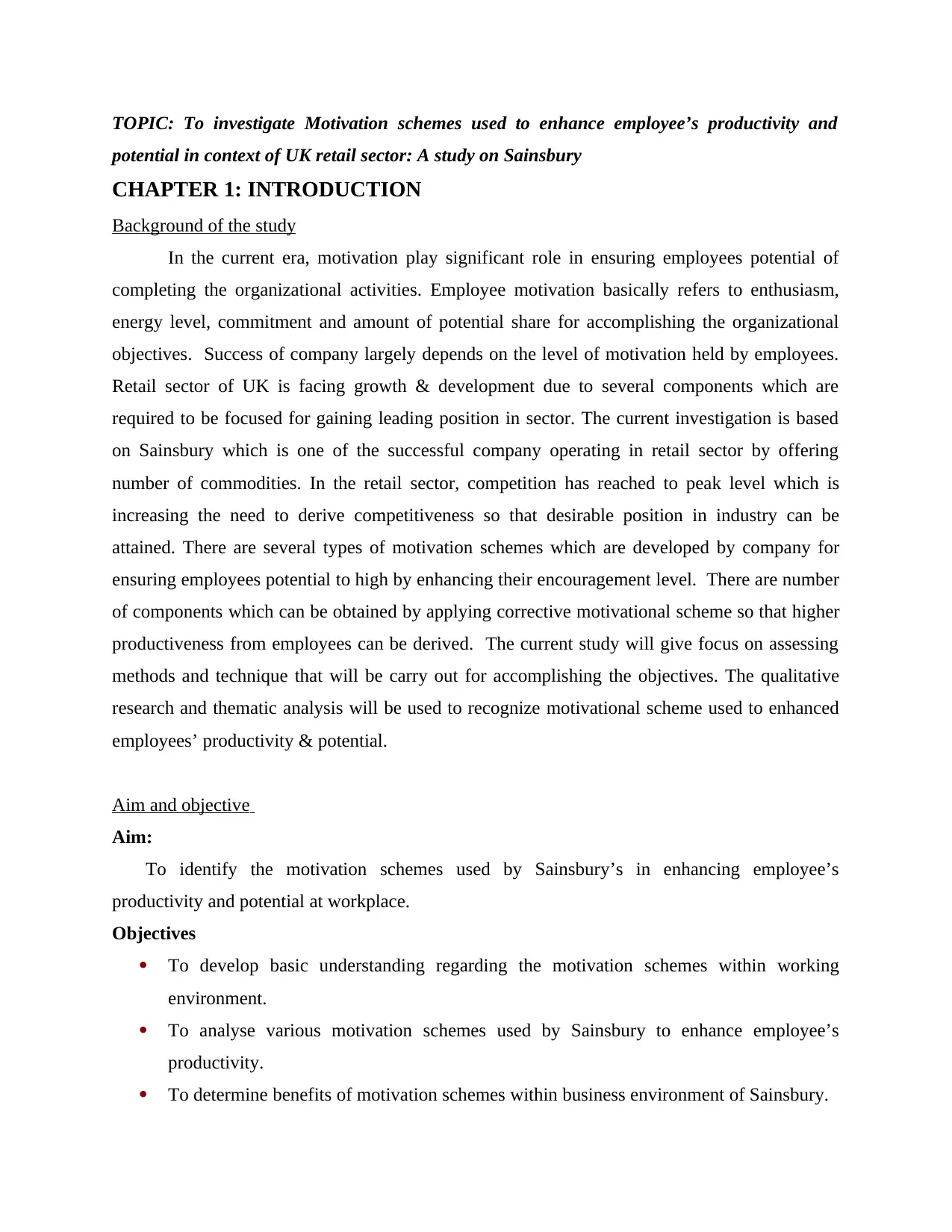
TOPIC: To investigate Motivation schemes used to enhance employee’s productivity and
potential in context of UK retail sector: A study on Sainsbury
CHAPTER 1: INTRODUCTION
Background of the study
In the current era, motivation play significant role in ensuring employees potential of
completing the organizational activities. Employee motivation basically refers to enthusiasm,
energy level, commitment and amount of potential share for accomplishing the organizational
objectives. Success of company largely depends on the level of motivation held by employees.
Retail sector of UK is facing growth & development due to several components which are
required to be focused for gaining leading position in sector. The current investigation is based
on Sainsbury which is one of the successful company operating in retail sector by offering
number of commodities. In the retail sector, competition has reached to peak level which is
increasing the need to derive competitiveness so that desirable position in industry can be
attained. There are several types of motivation schemes which are developed by company for
ensuring employees potential to high by enhancing their encouragement level. There are number
of components which can be obtained by applying corrective motivational scheme so that higher
productiveness from employees can be derived. The current study will give focus on assessing
methods and technique that will be carry out for accomplishing the objectives. The qualitative
research and thematic analysis will be used to recognize motivational scheme used to enhanced
employees’ productivity & potential.
Aim and objective
Aim:
To identify the motivation schemes used by Sainsbury’s in enhancing employee’s
productivity and potential at workplace.
Objectives
To develop basic understanding regarding the motivation schemes within working
environment.
To analyse various motivation schemes used by Sainsbury to enhance employee’s
productivity.
To determine benefits of motivation schemes within business environment of Sainsbury.
potential in context of UK retail sector: A study on Sainsbury
CHAPTER 1: INTRODUCTION
Background of the study
In the current era, motivation play significant role in ensuring employees potential of
completing the organizational activities. Employee motivation basically refers to enthusiasm,
energy level, commitment and amount of potential share for accomplishing the organizational
objectives. Success of company largely depends on the level of motivation held by employees.
Retail sector of UK is facing growth & development due to several components which are
required to be focused for gaining leading position in sector. The current investigation is based
on Sainsbury which is one of the successful company operating in retail sector by offering
number of commodities. In the retail sector, competition has reached to peak level which is
increasing the need to derive competitiveness so that desirable position in industry can be
attained. There are several types of motivation schemes which are developed by company for
ensuring employees potential to high by enhancing their encouragement level. There are number
of components which can be obtained by applying corrective motivational scheme so that higher
productiveness from employees can be derived. The current study will give focus on assessing
methods and technique that will be carry out for accomplishing the objectives. The qualitative
research and thematic analysis will be used to recognize motivational scheme used to enhanced
employees’ productivity & potential.
Aim and objective
Aim:
To identify the motivation schemes used by Sainsbury’s in enhancing employee’s
productivity and potential at workplace.
Objectives
To develop basic understanding regarding the motivation schemes within working
environment.
To analyse various motivation schemes used by Sainsbury to enhance employee’s
productivity.
To determine benefits of motivation schemes within business environment of Sainsbury.
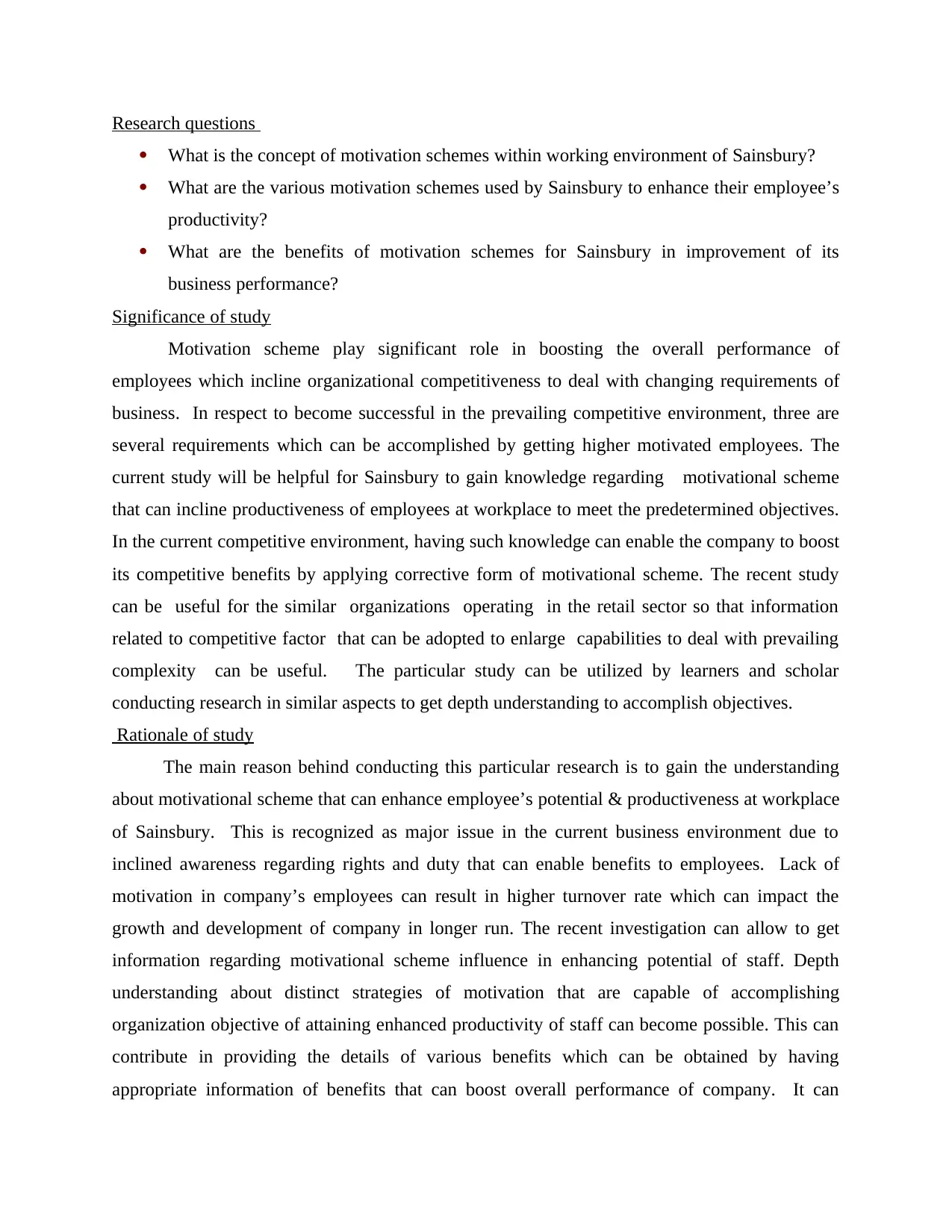
Research questions
What is the concept of motivation schemes within working environment of Sainsbury?
What are the various motivation schemes used by Sainsbury to enhance their employee’s
productivity?
What are the benefits of motivation schemes for Sainsbury in improvement of its
business performance?
Significance of study
Motivation scheme play significant role in boosting the overall performance of
employees which incline organizational competitiveness to deal with changing requirements of
business. In respect to become successful in the prevailing competitive environment, three are
several requirements which can be accomplished by getting higher motivated employees. The
current study will be helpful for Sainsbury to gain knowledge regarding motivational scheme
that can incline productiveness of employees at workplace to meet the predetermined objectives.
In the current competitive environment, having such knowledge can enable the company to boost
its competitive benefits by applying corrective form of motivational scheme. The recent study
can be useful for the similar organizations operating in the retail sector so that information
related to competitive factor that can be adopted to enlarge capabilities to deal with prevailing
complexity can be useful. The particular study can be utilized by learners and scholar
conducting research in similar aspects to get depth understanding to accomplish objectives.
Rationale of study
The main reason behind conducting this particular research is to gain the understanding
about motivational scheme that can enhance employee’s potential & productiveness at workplace
of Sainsbury. This is recognized as major issue in the current business environment due to
inclined awareness regarding rights and duty that can enable benefits to employees. Lack of
motivation in company’s employees can result in higher turnover rate which can impact the
growth and development of company in longer run. The recent investigation can allow to get
information regarding motivational scheme influence in enhancing potential of staff. Depth
understanding about distinct strategies of motivation that are capable of accomplishing
organization objective of attaining enhanced productivity of staff can become possible. This can
contribute in providing the details of various benefits which can be obtained by having
appropriate information of benefits that can boost overall performance of company. It can
What is the concept of motivation schemes within working environment of Sainsbury?
What are the various motivation schemes used by Sainsbury to enhance their employee’s
productivity?
What are the benefits of motivation schemes for Sainsbury in improvement of its
business performance?
Significance of study
Motivation scheme play significant role in boosting the overall performance of
employees which incline organizational competitiveness to deal with changing requirements of
business. In respect to become successful in the prevailing competitive environment, three are
several requirements which can be accomplished by getting higher motivated employees. The
current study will be helpful for Sainsbury to gain knowledge regarding motivational scheme
that can incline productiveness of employees at workplace to meet the predetermined objectives.
In the current competitive environment, having such knowledge can enable the company to boost
its competitive benefits by applying corrective form of motivational scheme. The recent study
can be useful for the similar organizations operating in the retail sector so that information
related to competitive factor that can be adopted to enlarge capabilities to deal with prevailing
complexity can be useful. The particular study can be utilized by learners and scholar
conducting research in similar aspects to get depth understanding to accomplish objectives.
Rationale of study
The main reason behind conducting this particular research is to gain the understanding
about motivational scheme that can enhance employee’s potential & productiveness at workplace
of Sainsbury. This is recognized as major issue in the current business environment due to
inclined awareness regarding rights and duty that can enable benefits to employees. Lack of
motivation in company’s employees can result in higher turnover rate which can impact the
growth and development of company in longer run. The recent investigation can allow to get
information regarding motivational scheme influence in enhancing potential of staff. Depth
understanding about distinct strategies of motivation that are capable of accomplishing
organization objective of attaining enhanced productivity of staff can become possible. This can
contribute in providing the details of various benefits which can be obtained by having
appropriate information of benefits that can boost overall performance of company. It can
Secure Best Marks with AI Grader
Need help grading? Try our AI Grader for instant feedback on your assignments.
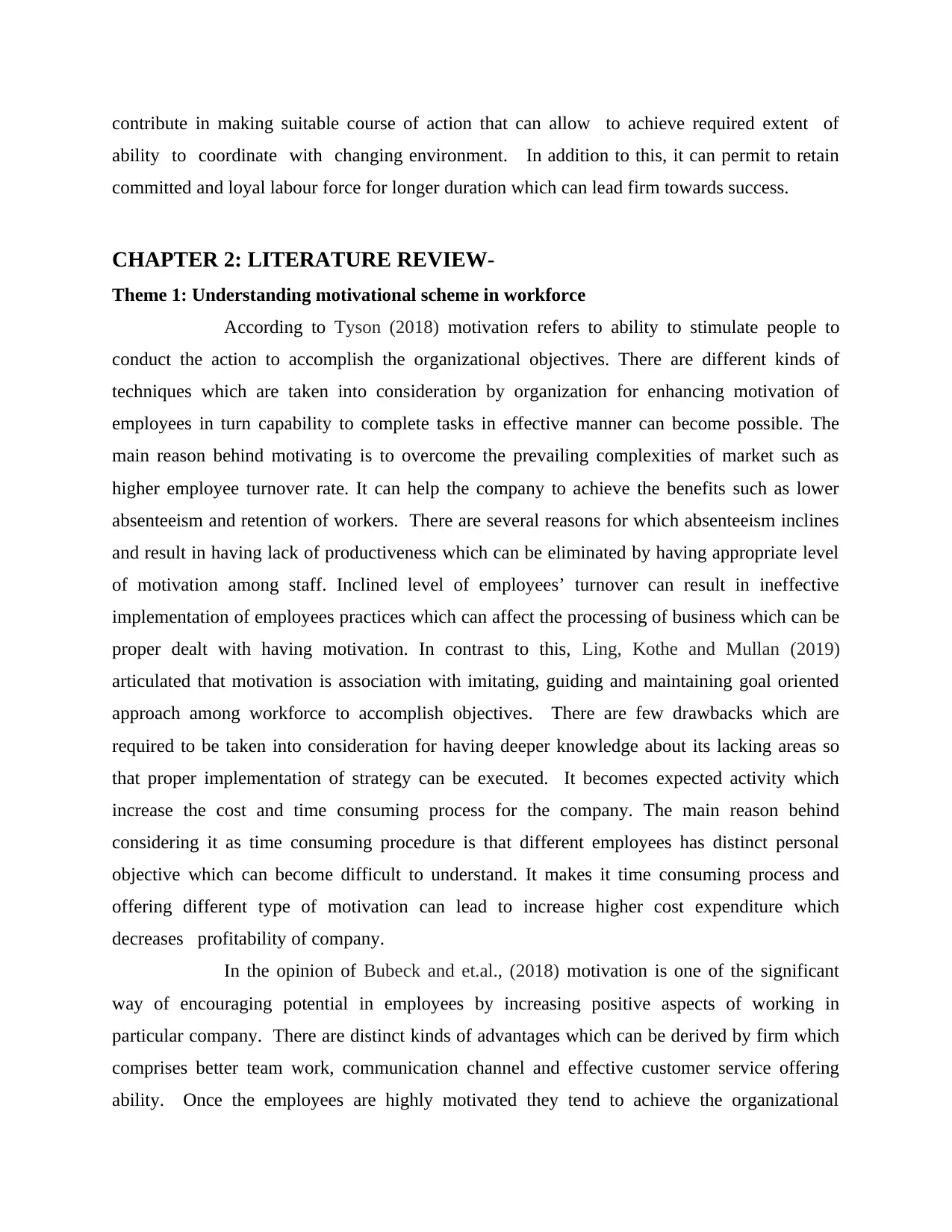
contribute in making suitable course of action that can allow to achieve required extent of
ability to coordinate with changing environment. In addition to this, it can permit to retain
committed and loyal labour force for longer duration which can lead firm towards success.
CHAPTER 2: LITERATURE REVIEW-
Theme 1: Understanding motivational scheme in workforce
According to Tyson (2018) motivation refers to ability to stimulate people to
conduct the action to accomplish the organizational objectives. There are different kinds of
techniques which are taken into consideration by organization for enhancing motivation of
employees in turn capability to complete tasks in effective manner can become possible. The
main reason behind motivating is to overcome the prevailing complexities of market such as
higher employee turnover rate. It can help the company to achieve the benefits such as lower
absenteeism and retention of workers. There are several reasons for which absenteeism inclines
and result in having lack of productiveness which can be eliminated by having appropriate level
of motivation among staff. Inclined level of employees’ turnover can result in ineffective
implementation of employees practices which can affect the processing of business which can be
proper dealt with having motivation. In contrast to this, Ling, Kothe and Mullan (2019)
articulated that motivation is association with imitating, guiding and maintaining goal oriented
approach among workforce to accomplish objectives. There are few drawbacks which are
required to be taken into consideration for having deeper knowledge about its lacking areas so
that proper implementation of strategy can be executed. It becomes expected activity which
increase the cost and time consuming process for the company. The main reason behind
considering it as time consuming procedure is that different employees has distinct personal
objective which can become difficult to understand. It makes it time consuming process and
offering different type of motivation can lead to increase higher cost expenditure which
decreases profitability of company.
In the opinion of Bubeck and et.al., (2018) motivation is one of the significant
way of encouraging potential in employees by increasing positive aspects of working in
particular company. There are distinct kinds of advantages which can be derived by firm which
comprises better team work, communication channel and effective customer service offering
ability. Once the employees are highly motivated they tend to achieve the organizational
ability to coordinate with changing environment. In addition to this, it can permit to retain
committed and loyal labour force for longer duration which can lead firm towards success.
CHAPTER 2: LITERATURE REVIEW-
Theme 1: Understanding motivational scheme in workforce
According to Tyson (2018) motivation refers to ability to stimulate people to
conduct the action to accomplish the organizational objectives. There are different kinds of
techniques which are taken into consideration by organization for enhancing motivation of
employees in turn capability to complete tasks in effective manner can become possible. The
main reason behind motivating is to overcome the prevailing complexities of market such as
higher employee turnover rate. It can help the company to achieve the benefits such as lower
absenteeism and retention of workers. There are several reasons for which absenteeism inclines
and result in having lack of productiveness which can be eliminated by having appropriate level
of motivation among staff. Inclined level of employees’ turnover can result in ineffective
implementation of employees practices which can affect the processing of business which can be
proper dealt with having motivation. In contrast to this, Ling, Kothe and Mullan (2019)
articulated that motivation is association with imitating, guiding and maintaining goal oriented
approach among workforce to accomplish objectives. There are few drawbacks which are
required to be taken into consideration for having deeper knowledge about its lacking areas so
that proper implementation of strategy can be executed. It becomes expected activity which
increase the cost and time consuming process for the company. The main reason behind
considering it as time consuming procedure is that different employees has distinct personal
objective which can become difficult to understand. It makes it time consuming process and
offering different type of motivation can lead to increase higher cost expenditure which
decreases profitability of company.
In the opinion of Bubeck and et.al., (2018) motivation is one of the significant
way of encouraging potential in employees by increasing positive aspects of working in
particular company. There are distinct kinds of advantages which can be derived by firm which
comprises better team work, communication channel and effective customer service offering
ability. Once the employees are highly motivated they tend to achieve the organizational
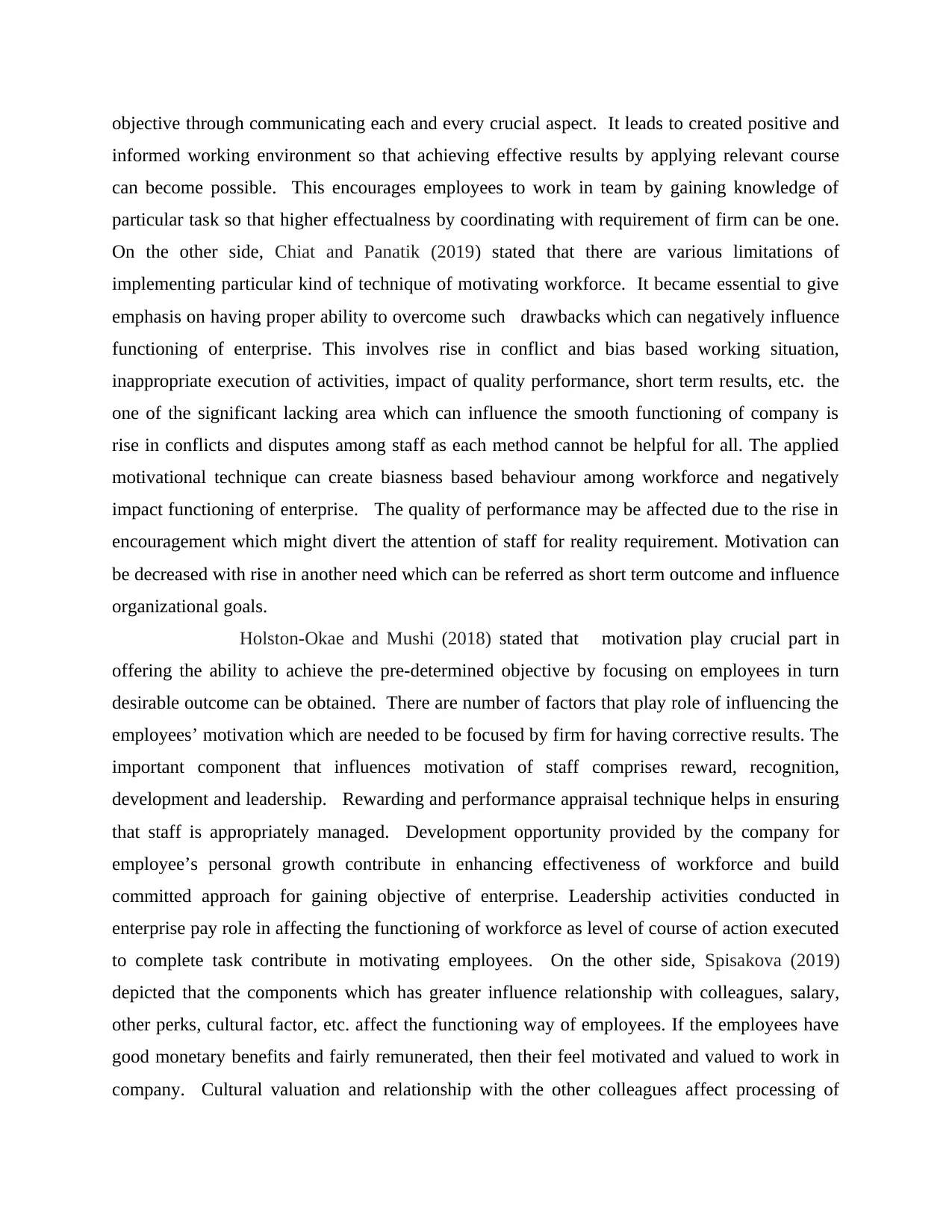
objective through communicating each and every crucial aspect. It leads to created positive and
informed working environment so that achieving effective results by applying relevant course
can become possible. This encourages employees to work in team by gaining knowledge of
particular task so that higher effectualness by coordinating with requirement of firm can be one.
On the other side, Chiat and Panatik (2019) stated that there are various limitations of
implementing particular kind of technique of motivating workforce. It became essential to give
emphasis on having proper ability to overcome such drawbacks which can negatively influence
functioning of enterprise. This involves rise in conflict and bias based working situation,
inappropriate execution of activities, impact of quality performance, short term results, etc. the
one of the significant lacking area which can influence the smooth functioning of company is
rise in conflicts and disputes among staff as each method cannot be helpful for all. The applied
motivational technique can create biasness based behaviour among workforce and negatively
impact functioning of enterprise. The quality of performance may be affected due to the rise in
encouragement which might divert the attention of staff for reality requirement. Motivation can
be decreased with rise in another need which can be referred as short term outcome and influence
organizational goals.
Holston-Okae and Mushi (2018) stated that motivation play crucial part in
offering the ability to achieve the pre-determined objective by focusing on employees in turn
desirable outcome can be obtained. There are number of factors that play role of influencing the
employees’ motivation which are needed to be focused by firm for having corrective results. The
important component that influences motivation of staff comprises reward, recognition,
development and leadership. Rewarding and performance appraisal technique helps in ensuring
that staff is appropriately managed. Development opportunity provided by the company for
employee’s personal growth contribute in enhancing effectiveness of workforce and build
committed approach for gaining objective of enterprise. Leadership activities conducted in
enterprise pay role in affecting the functioning of workforce as level of course of action executed
to complete task contribute in motivating employees. On the other side, Spisakova (2019)
depicted that the components which has greater influence relationship with colleagues, salary,
other perks, cultural factor, etc. affect the functioning way of employees. If the employees have
good monetary benefits and fairly remunerated, then their feel motivated and valued to work in
company. Cultural valuation and relationship with the other colleagues affect processing of
informed working environment so that achieving effective results by applying relevant course
can become possible. This encourages employees to work in team by gaining knowledge of
particular task so that higher effectualness by coordinating with requirement of firm can be one.
On the other side, Chiat and Panatik (2019) stated that there are various limitations of
implementing particular kind of technique of motivating workforce. It became essential to give
emphasis on having proper ability to overcome such drawbacks which can negatively influence
functioning of enterprise. This involves rise in conflict and bias based working situation,
inappropriate execution of activities, impact of quality performance, short term results, etc. the
one of the significant lacking area which can influence the smooth functioning of company is
rise in conflicts and disputes among staff as each method cannot be helpful for all. The applied
motivational technique can create biasness based behaviour among workforce and negatively
impact functioning of enterprise. The quality of performance may be affected due to the rise in
encouragement which might divert the attention of staff for reality requirement. Motivation can
be decreased with rise in another need which can be referred as short term outcome and influence
organizational goals.
Holston-Okae and Mushi (2018) stated that motivation play crucial part in
offering the ability to achieve the pre-determined objective by focusing on employees in turn
desirable outcome can be obtained. There are number of factors that play role of influencing the
employees’ motivation which are needed to be focused by firm for having corrective results. The
important component that influences motivation of staff comprises reward, recognition,
development and leadership. Rewarding and performance appraisal technique helps in ensuring
that staff is appropriately managed. Development opportunity provided by the company for
employee’s personal growth contribute in enhancing effectiveness of workforce and build
committed approach for gaining objective of enterprise. Leadership activities conducted in
enterprise pay role in affecting the functioning of workforce as level of course of action executed
to complete task contribute in motivating employees. On the other side, Spisakova (2019)
depicted that the components which has greater influence relationship with colleagues, salary,
other perks, cultural factor, etc. affect the functioning way of employees. If the employees have
good monetary benefits and fairly remunerated, then their feel motivated and valued to work in
company. Cultural valuation and relationship with the other colleagues affect processing of
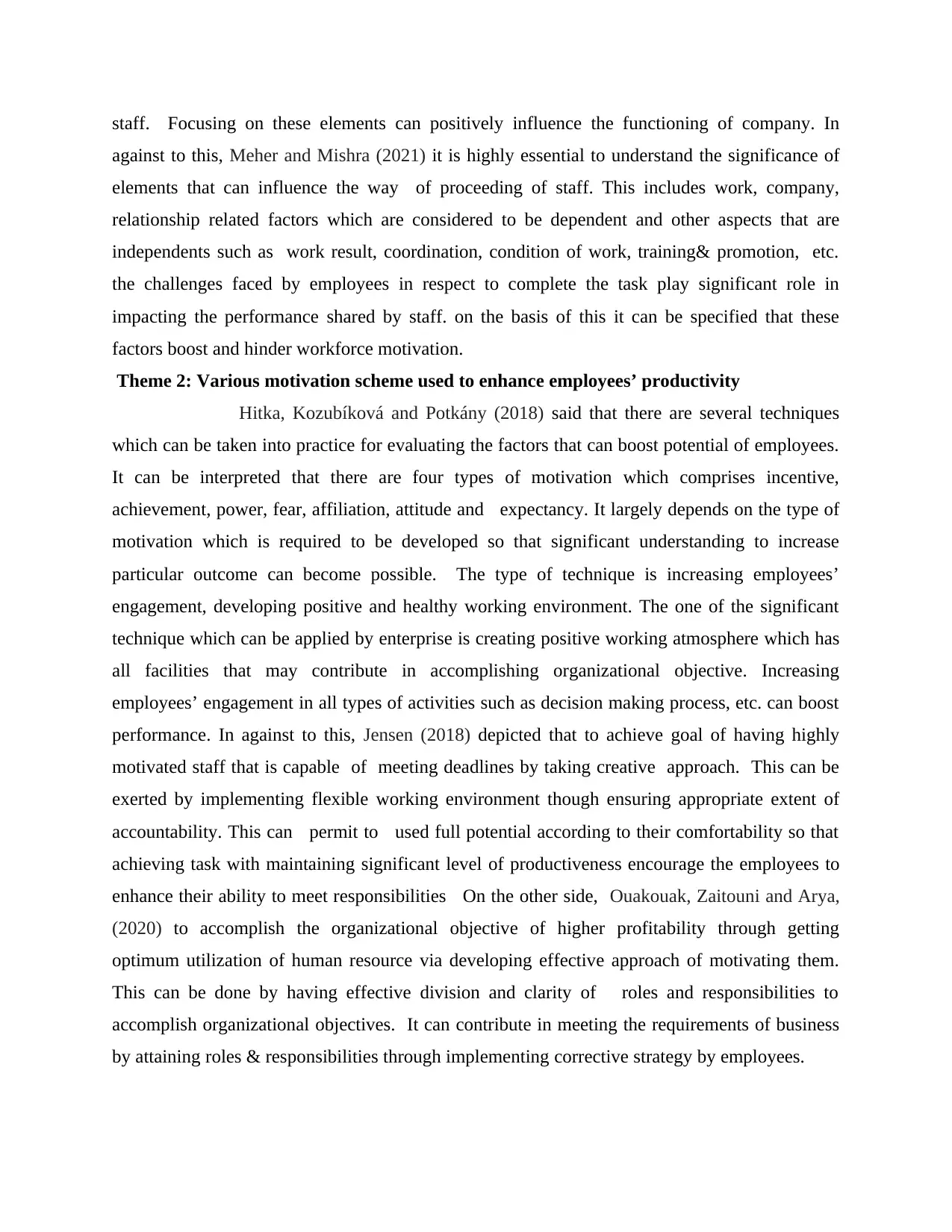
staff. Focusing on these elements can positively influence the functioning of company. In
against to this, Meher and Mishra (2021) it is highly essential to understand the significance of
elements that can influence the way of proceeding of staff. This includes work, company,
relationship related factors which are considered to be dependent and other aspects that are
independents such as work result, coordination, condition of work, training& promotion, etc.
the challenges faced by employees in respect to complete the task play significant role in
impacting the performance shared by staff. on the basis of this it can be specified that these
factors boost and hinder workforce motivation.
Theme 2: Various motivation scheme used to enhance employees’ productivity
Hitka, Kozubíková and Potkány (2018) said that there are several techniques
which can be taken into practice for evaluating the factors that can boost potential of employees.
It can be interpreted that there are four types of motivation which comprises incentive,
achievement, power, fear, affiliation, attitude and expectancy. It largely depends on the type of
motivation which is required to be developed so that significant understanding to increase
particular outcome can become possible. The type of technique is increasing employees’
engagement, developing positive and healthy working environment. The one of the significant
technique which can be applied by enterprise is creating positive working atmosphere which has
all facilities that may contribute in accomplishing organizational objective. Increasing
employees’ engagement in all types of activities such as decision making process, etc. can boost
performance. In against to this, Jensen (2018) depicted that to achieve goal of having highly
motivated staff that is capable of meeting deadlines by taking creative approach. This can be
exerted by implementing flexible working environment though ensuring appropriate extent of
accountability. This can permit to used full potential according to their comfortability so that
achieving task with maintaining significant level of productiveness encourage the employees to
enhance their ability to meet responsibilities On the other side, Ouakouak, Zaitouni and Arya,
(2020) to accomplish the organizational objective of higher profitability through getting
optimum utilization of human resource via developing effective approach of motivating them.
This can be done by having effective division and clarity of roles and responsibilities to
accomplish organizational objectives. It can contribute in meeting the requirements of business
by attaining roles & responsibilities through implementing corrective strategy by employees.
against to this, Meher and Mishra (2021) it is highly essential to understand the significance of
elements that can influence the way of proceeding of staff. This includes work, company,
relationship related factors which are considered to be dependent and other aspects that are
independents such as work result, coordination, condition of work, training& promotion, etc.
the challenges faced by employees in respect to complete the task play significant role in
impacting the performance shared by staff. on the basis of this it can be specified that these
factors boost and hinder workforce motivation.
Theme 2: Various motivation scheme used to enhance employees’ productivity
Hitka, Kozubíková and Potkány (2018) said that there are several techniques
which can be taken into practice for evaluating the factors that can boost potential of employees.
It can be interpreted that there are four types of motivation which comprises incentive,
achievement, power, fear, affiliation, attitude and expectancy. It largely depends on the type of
motivation which is required to be developed so that significant understanding to increase
particular outcome can become possible. The type of technique is increasing employees’
engagement, developing positive and healthy working environment. The one of the significant
technique which can be applied by enterprise is creating positive working atmosphere which has
all facilities that may contribute in accomplishing organizational objective. Increasing
employees’ engagement in all types of activities such as decision making process, etc. can boost
performance. In against to this, Jensen (2018) depicted that to achieve goal of having highly
motivated staff that is capable of meeting deadlines by taking creative approach. This can be
exerted by implementing flexible working environment though ensuring appropriate extent of
accountability. This can permit to used full potential according to their comfortability so that
achieving task with maintaining significant level of productiveness encourage the employees to
enhance their ability to meet responsibilities On the other side, Ouakouak, Zaitouni and Arya,
(2020) to accomplish the organizational objective of higher profitability through getting
optimum utilization of human resource via developing effective approach of motivating them.
This can be done by having effective division and clarity of roles and responsibilities to
accomplish organizational objectives. It can contribute in meeting the requirements of business
by attaining roles & responsibilities through implementing corrective strategy by employees.
Paraphrase This Document
Need a fresh take? Get an instant paraphrase of this document with our AI Paraphraser
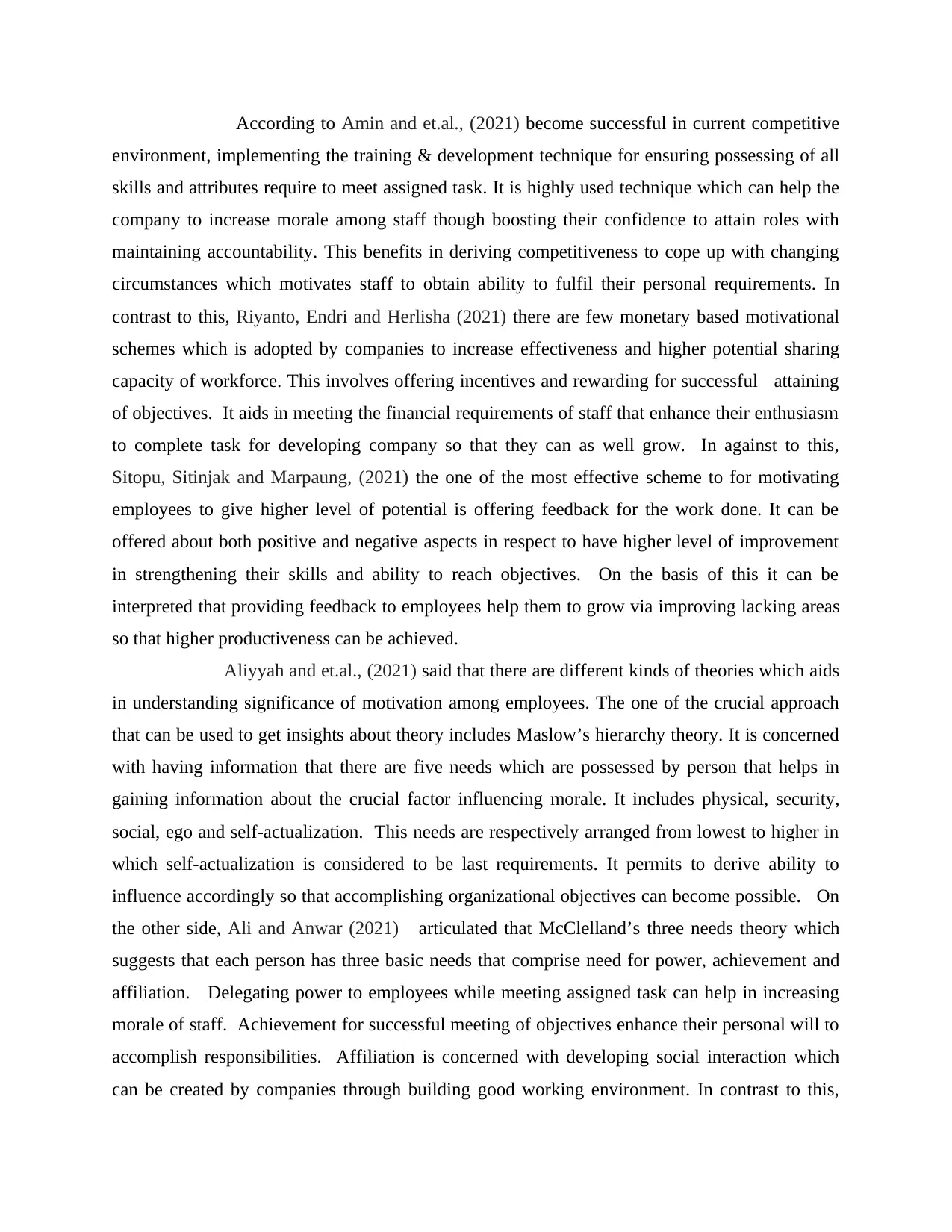
According to Amin and et.al., (2021) become successful in current competitive
environment, implementing the training & development technique for ensuring possessing of all
skills and attributes require to meet assigned task. It is highly used technique which can help the
company to increase morale among staff though boosting their confidence to attain roles with
maintaining accountability. This benefits in deriving competitiveness to cope up with changing
circumstances which motivates staff to obtain ability to fulfil their personal requirements. In
contrast to this, Riyanto, Endri and Herlisha (2021) there are few monetary based motivational
schemes which is adopted by companies to increase effectiveness and higher potential sharing
capacity of workforce. This involves offering incentives and rewarding for successful attaining
of objectives. It aids in meeting the financial requirements of staff that enhance their enthusiasm
to complete task for developing company so that they can as well grow. In against to this,
Sitopu, Sitinjak and Marpaung, (2021) the one of the most effective scheme to for motivating
employees to give higher level of potential is offering feedback for the work done. It can be
offered about both positive and negative aspects in respect to have higher level of improvement
in strengthening their skills and ability to reach objectives. On the basis of this it can be
interpreted that providing feedback to employees help them to grow via improving lacking areas
so that higher productiveness can be achieved.
Aliyyah and et.al., (2021) said that there are different kinds of theories which aids
in understanding significance of motivation among employees. The one of the crucial approach
that can be used to get insights about theory includes Maslow’s hierarchy theory. It is concerned
with having information that there are five needs which are possessed by person that helps in
gaining information about the crucial factor influencing morale. It includes physical, security,
social, ego and self-actualization. This needs are respectively arranged from lowest to higher in
which self-actualization is considered to be last requirements. It permits to derive ability to
influence accordingly so that accomplishing organizational objectives can become possible. On
the other side, Ali and Anwar (2021) articulated that McClelland’s three needs theory which
suggests that each person has three basic needs that comprise need for power, achievement and
affiliation. Delegating power to employees while meeting assigned task can help in increasing
morale of staff. Achievement for successful meeting of objectives enhance their personal will to
accomplish responsibilities. Affiliation is concerned with developing social interaction which
can be created by companies through building good working environment. In contrast to this,
environment, implementing the training & development technique for ensuring possessing of all
skills and attributes require to meet assigned task. It is highly used technique which can help the
company to increase morale among staff though boosting their confidence to attain roles with
maintaining accountability. This benefits in deriving competitiveness to cope up with changing
circumstances which motivates staff to obtain ability to fulfil their personal requirements. In
contrast to this, Riyanto, Endri and Herlisha (2021) there are few monetary based motivational
schemes which is adopted by companies to increase effectiveness and higher potential sharing
capacity of workforce. This involves offering incentives and rewarding for successful attaining
of objectives. It aids in meeting the financial requirements of staff that enhance their enthusiasm
to complete task for developing company so that they can as well grow. In against to this,
Sitopu, Sitinjak and Marpaung, (2021) the one of the most effective scheme to for motivating
employees to give higher level of potential is offering feedback for the work done. It can be
offered about both positive and negative aspects in respect to have higher level of improvement
in strengthening their skills and ability to reach objectives. On the basis of this it can be
interpreted that providing feedback to employees help them to grow via improving lacking areas
so that higher productiveness can be achieved.
Aliyyah and et.al., (2021) said that there are different kinds of theories which aids
in understanding significance of motivation among employees. The one of the crucial approach
that can be used to get insights about theory includes Maslow’s hierarchy theory. It is concerned
with having information that there are five needs which are possessed by person that helps in
gaining information about the crucial factor influencing morale. It includes physical, security,
social, ego and self-actualization. This needs are respectively arranged from lowest to higher in
which self-actualization is considered to be last requirements. It permits to derive ability to
influence accordingly so that accomplishing organizational objectives can become possible. On
the other side, Ali and Anwar (2021) articulated that McClelland’s three needs theory which
suggests that each person has three basic needs that comprise need for power, achievement and
affiliation. Delegating power to employees while meeting assigned task can help in increasing
morale of staff. Achievement for successful meeting of objectives enhance their personal will to
accomplish responsibilities. Affiliation is concerned with developing social interaction which
can be created by companies through building good working environment. In contrast to this,
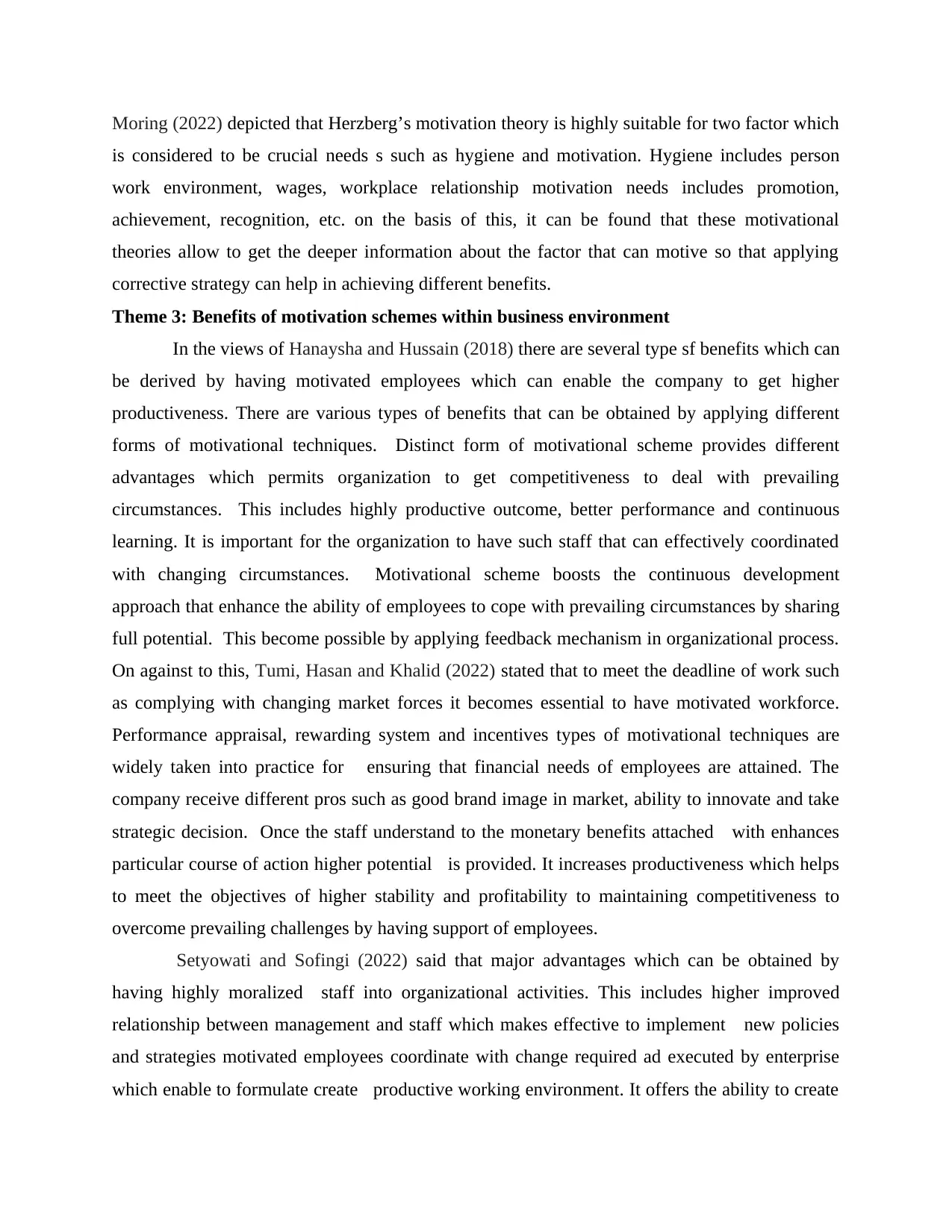
Moring (2022) depicted that Herzberg’s motivation theory is highly suitable for two factor which
is considered to be crucial needs s such as hygiene and motivation. Hygiene includes person
work environment, wages, workplace relationship motivation needs includes promotion,
achievement, recognition, etc. on the basis of this, it can be found that these motivational
theories allow to get the deeper information about the factor that can motive so that applying
corrective strategy can help in achieving different benefits.
Theme 3: Benefits of motivation schemes within business environment
In the views of Hanaysha and Hussain (2018) there are several type sf benefits which can
be derived by having motivated employees which can enable the company to get higher
productiveness. There are various types of benefits that can be obtained by applying different
forms of motivational techniques. Distinct form of motivational scheme provides different
advantages which permits organization to get competitiveness to deal with prevailing
circumstances. This includes highly productive outcome, better performance and continuous
learning. It is important for the organization to have such staff that can effectively coordinated
with changing circumstances. Motivational scheme boosts the continuous development
approach that enhance the ability of employees to cope with prevailing circumstances by sharing
full potential. This become possible by applying feedback mechanism in organizational process.
On against to this, Tumi, Hasan and Khalid (2022) stated that to meet the deadline of work such
as complying with changing market forces it becomes essential to have motivated workforce.
Performance appraisal, rewarding system and incentives types of motivational techniques are
widely taken into practice for ensuring that financial needs of employees are attained. The
company receive different pros such as good brand image in market, ability to innovate and take
strategic decision. Once the staff understand to the monetary benefits attached with enhances
particular course of action higher potential is provided. It increases productiveness which helps
to meet the objectives of higher stability and profitability to maintaining competitiveness to
overcome prevailing challenges by having support of employees.
Setyowati and Sofingi (2022) said that major advantages which can be obtained by
having highly moralized staff into organizational activities. This includes higher improved
relationship between management and staff which makes effective to implement new policies
and strategies motivated employees coordinate with change required ad executed by enterprise
which enable to formulate create productive working environment. It offers the ability to create
is considered to be crucial needs s such as hygiene and motivation. Hygiene includes person
work environment, wages, workplace relationship motivation needs includes promotion,
achievement, recognition, etc. on the basis of this, it can be found that these motivational
theories allow to get the deeper information about the factor that can motive so that applying
corrective strategy can help in achieving different benefits.
Theme 3: Benefits of motivation schemes within business environment
In the views of Hanaysha and Hussain (2018) there are several type sf benefits which can
be derived by having motivated employees which can enable the company to get higher
productiveness. There are various types of benefits that can be obtained by applying different
forms of motivational techniques. Distinct form of motivational scheme provides different
advantages which permits organization to get competitiveness to deal with prevailing
circumstances. This includes highly productive outcome, better performance and continuous
learning. It is important for the organization to have such staff that can effectively coordinated
with changing circumstances. Motivational scheme boosts the continuous development
approach that enhance the ability of employees to cope with prevailing circumstances by sharing
full potential. This become possible by applying feedback mechanism in organizational process.
On against to this, Tumi, Hasan and Khalid (2022) stated that to meet the deadline of work such
as complying with changing market forces it becomes essential to have motivated workforce.
Performance appraisal, rewarding system and incentives types of motivational techniques are
widely taken into practice for ensuring that financial needs of employees are attained. The
company receive different pros such as good brand image in market, ability to innovate and take
strategic decision. Once the staff understand to the monetary benefits attached with enhances
particular course of action higher potential is provided. It increases productiveness which helps
to meet the objectives of higher stability and profitability to maintaining competitiveness to
overcome prevailing challenges by having support of employees.
Setyowati and Sofingi (2022) said that major advantages which can be obtained by
having highly moralized staff into organizational activities. This includes higher improved
relationship between management and staff which makes effective to implement new policies
and strategies motivated employees coordinate with change required ad executed by enterprise
which enable to formulate create productive working environment. It offers the ability to create
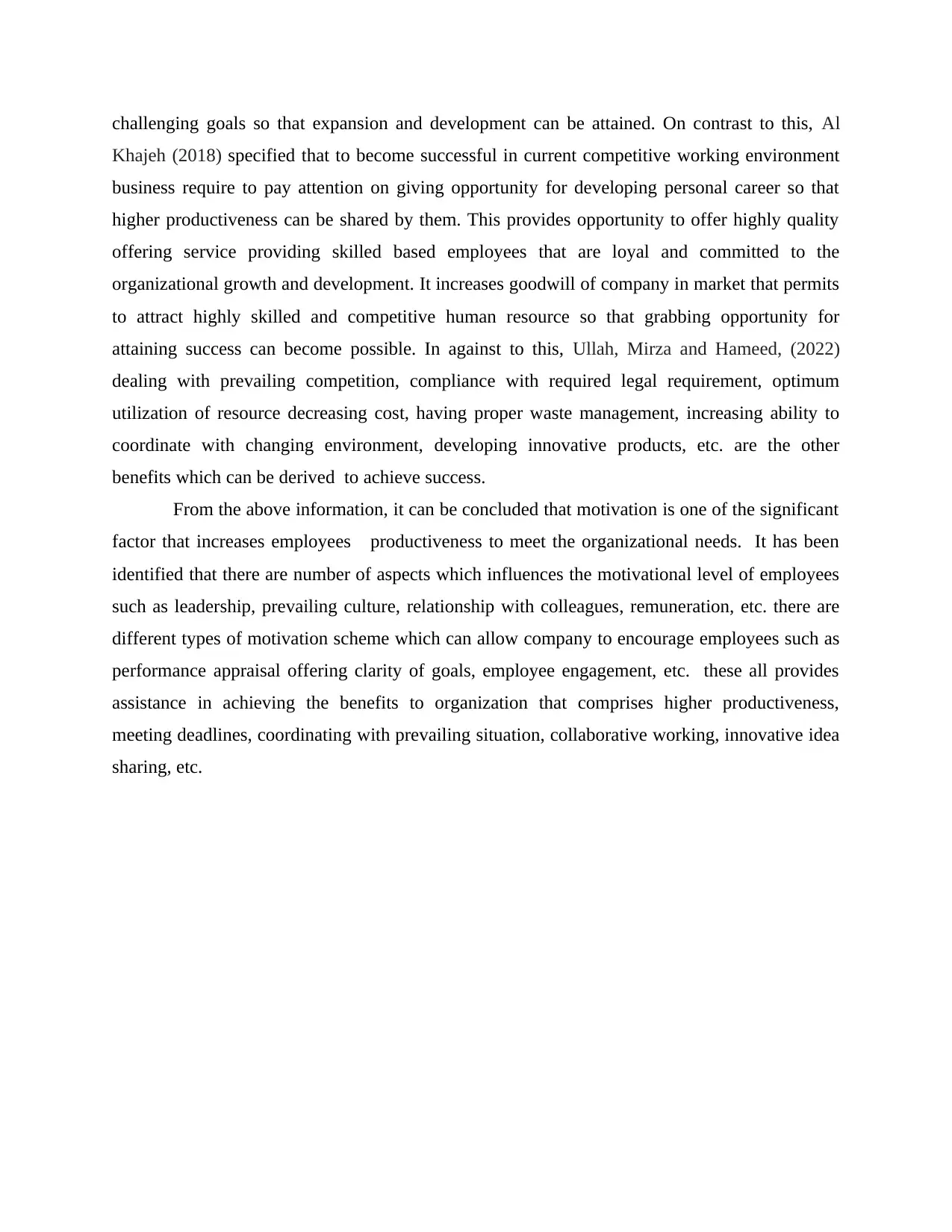
challenging goals so that expansion and development can be attained. On contrast to this, Al
Khajeh (2018) specified that to become successful in current competitive working environment
business require to pay attention on giving opportunity for developing personal career so that
higher productiveness can be shared by them. This provides opportunity to offer highly quality
offering service providing skilled based employees that are loyal and committed to the
organizational growth and development. It increases goodwill of company in market that permits
to attract highly skilled and competitive human resource so that grabbing opportunity for
attaining success can become possible. In against to this, Ullah, Mirza and Hameed, (2022)
dealing with prevailing competition, compliance with required legal requirement, optimum
utilization of resource decreasing cost, having proper waste management, increasing ability to
coordinate with changing environment, developing innovative products, etc. are the other
benefits which can be derived to achieve success.
From the above information, it can be concluded that motivation is one of the significant
factor that increases employees productiveness to meet the organizational needs. It has been
identified that there are number of aspects which influences the motivational level of employees
such as leadership, prevailing culture, relationship with colleagues, remuneration, etc. there are
different types of motivation scheme which can allow company to encourage employees such as
performance appraisal offering clarity of goals, employee engagement, etc. these all provides
assistance in achieving the benefits to organization that comprises higher productiveness,
meeting deadlines, coordinating with prevailing situation, collaborative working, innovative idea
sharing, etc.
Khajeh (2018) specified that to become successful in current competitive working environment
business require to pay attention on giving opportunity for developing personal career so that
higher productiveness can be shared by them. This provides opportunity to offer highly quality
offering service providing skilled based employees that are loyal and committed to the
organizational growth and development. It increases goodwill of company in market that permits
to attract highly skilled and competitive human resource so that grabbing opportunity for
attaining success can become possible. In against to this, Ullah, Mirza and Hameed, (2022)
dealing with prevailing competition, compliance with required legal requirement, optimum
utilization of resource decreasing cost, having proper waste management, increasing ability to
coordinate with changing environment, developing innovative products, etc. are the other
benefits which can be derived to achieve success.
From the above information, it can be concluded that motivation is one of the significant
factor that increases employees productiveness to meet the organizational needs. It has been
identified that there are number of aspects which influences the motivational level of employees
such as leadership, prevailing culture, relationship with colleagues, remuneration, etc. there are
different types of motivation scheme which can allow company to encourage employees such as
performance appraisal offering clarity of goals, employee engagement, etc. these all provides
assistance in achieving the benefits to organization that comprises higher productiveness,
meeting deadlines, coordinating with prevailing situation, collaborative working, innovative idea
sharing, etc.
Secure Best Marks with AI Grader
Need help grading? Try our AI Grader for instant feedback on your assignments.
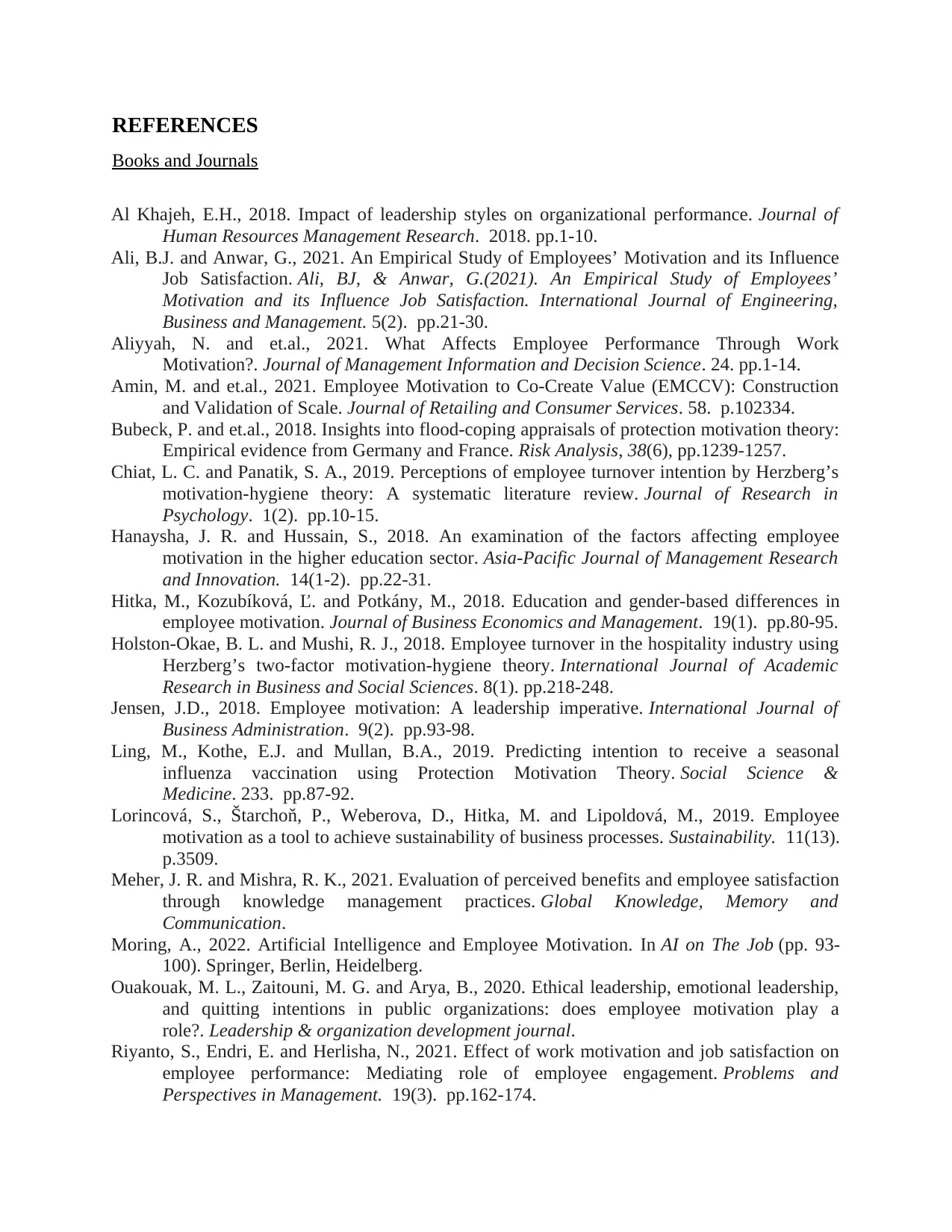
REFERENCES
Books and Journals
Al Khajeh, E.H., 2018. Impact of leadership styles on organizational performance. Journal of
Human Resources Management Research. 2018. pp.1-10.
Ali, B.J. and Anwar, G., 2021. An Empirical Study of Employees’ Motivation and its Influence
Job Satisfaction. Ali, BJ, & Anwar, G.(2021). An Empirical Study of Employees’
Motivation and its Influence Job Satisfaction. International Journal of Engineering,
Business and Management. 5(2). pp.21-30.
Aliyyah, N. and et.al., 2021. What Affects Employee Performance Through Work
Motivation?. Journal of Management Information and Decision Science. 24. pp.1-14.
Amin, M. and et.al., 2021. Employee Motivation to Co-Create Value (EMCCV): Construction
and Validation of Scale. Journal of Retailing and Consumer Services. 58. p.102334.
Bubeck, P. and et.al., 2018. Insights into flood‐coping appraisals of protection motivation theory:
Empirical evidence from Germany and France. Risk Analysis, 38(6), pp.1239-1257.
Chiat, L. C. and Panatik, S. A., 2019. Perceptions of employee turnover intention by Herzberg’s
motivation-hygiene theory: A systematic literature review. Journal of Research in
Psychology. 1(2). pp.10-15.
Hanaysha, J. R. and Hussain, S., 2018. An examination of the factors affecting employee
motivation in the higher education sector. Asia-Pacific Journal of Management Research
and Innovation. 14(1-2). pp.22-31.
Hitka, M., Kozubíková, Ľ. and Potkány, M., 2018. Education and gender-based differences in
employee motivation. Journal of Business Economics and Management. 19(1). pp.80-95.
Holston-Okae, B. L. and Mushi, R. J., 2018. Employee turnover in the hospitality industry using
Herzberg’s two-factor motivation-hygiene theory. International Journal of Academic
Research in Business and Social Sciences. 8(1). pp.218-248.
Jensen, J.D., 2018. Employee motivation: A leadership imperative. International Journal of
Business Administration. 9(2). pp.93-98.
Ling, M., Kothe, E.J. and Mullan, B.A., 2019. Predicting intention to receive a seasonal
influenza vaccination using Protection Motivation Theory. Social Science &
Medicine. 233. pp.87-92.
Lorincová, S., Štarchoň, P., Weberova, D., Hitka, M. and Lipoldová, M., 2019. Employee
motivation as a tool to achieve sustainability of business processes. Sustainability. 11(13).
p.3509.
Meher, J. R. and Mishra, R. K., 2021. Evaluation of perceived benefits and employee satisfaction
through knowledge management practices. Global Knowledge, Memory and
Communication.
Moring, A., 2022. Artificial Intelligence and Employee Motivation. In AI on The Job (pp. 93-
100). Springer, Berlin, Heidelberg.
Ouakouak, M. L., Zaitouni, M. G. and Arya, B., 2020. Ethical leadership, emotional leadership,
and quitting intentions in public organizations: does employee motivation play a
role?. Leadership & organization development journal.
Riyanto, S., Endri, E. and Herlisha, N., 2021. Effect of work motivation and job satisfaction on
employee performance: Mediating role of employee engagement. Problems and
Perspectives in Management. 19(3). pp.162-174.
Books and Journals
Al Khajeh, E.H., 2018. Impact of leadership styles on organizational performance. Journal of
Human Resources Management Research. 2018. pp.1-10.
Ali, B.J. and Anwar, G., 2021. An Empirical Study of Employees’ Motivation and its Influence
Job Satisfaction. Ali, BJ, & Anwar, G.(2021). An Empirical Study of Employees’
Motivation and its Influence Job Satisfaction. International Journal of Engineering,
Business and Management. 5(2). pp.21-30.
Aliyyah, N. and et.al., 2021. What Affects Employee Performance Through Work
Motivation?. Journal of Management Information and Decision Science. 24. pp.1-14.
Amin, M. and et.al., 2021. Employee Motivation to Co-Create Value (EMCCV): Construction
and Validation of Scale. Journal of Retailing and Consumer Services. 58. p.102334.
Bubeck, P. and et.al., 2018. Insights into flood‐coping appraisals of protection motivation theory:
Empirical evidence from Germany and France. Risk Analysis, 38(6), pp.1239-1257.
Chiat, L. C. and Panatik, S. A., 2019. Perceptions of employee turnover intention by Herzberg’s
motivation-hygiene theory: A systematic literature review. Journal of Research in
Psychology. 1(2). pp.10-15.
Hanaysha, J. R. and Hussain, S., 2018. An examination of the factors affecting employee
motivation in the higher education sector. Asia-Pacific Journal of Management Research
and Innovation. 14(1-2). pp.22-31.
Hitka, M., Kozubíková, Ľ. and Potkány, M., 2018. Education and gender-based differences in
employee motivation. Journal of Business Economics and Management. 19(1). pp.80-95.
Holston-Okae, B. L. and Mushi, R. J., 2018. Employee turnover in the hospitality industry using
Herzberg’s two-factor motivation-hygiene theory. International Journal of Academic
Research in Business and Social Sciences. 8(1). pp.218-248.
Jensen, J.D., 2018. Employee motivation: A leadership imperative. International Journal of
Business Administration. 9(2). pp.93-98.
Ling, M., Kothe, E.J. and Mullan, B.A., 2019. Predicting intention to receive a seasonal
influenza vaccination using Protection Motivation Theory. Social Science &
Medicine. 233. pp.87-92.
Lorincová, S., Štarchoň, P., Weberova, D., Hitka, M. and Lipoldová, M., 2019. Employee
motivation as a tool to achieve sustainability of business processes. Sustainability. 11(13).
p.3509.
Meher, J. R. and Mishra, R. K., 2021. Evaluation of perceived benefits and employee satisfaction
through knowledge management practices. Global Knowledge, Memory and
Communication.
Moring, A., 2022. Artificial Intelligence and Employee Motivation. In AI on The Job (pp. 93-
100). Springer, Berlin, Heidelberg.
Ouakouak, M. L., Zaitouni, M. G. and Arya, B., 2020. Ethical leadership, emotional leadership,
and quitting intentions in public organizations: does employee motivation play a
role?. Leadership & organization development journal.
Riyanto, S., Endri, E. and Herlisha, N., 2021. Effect of work motivation and job satisfaction on
employee performance: Mediating role of employee engagement. Problems and
Perspectives in Management. 19(3). pp.162-174.
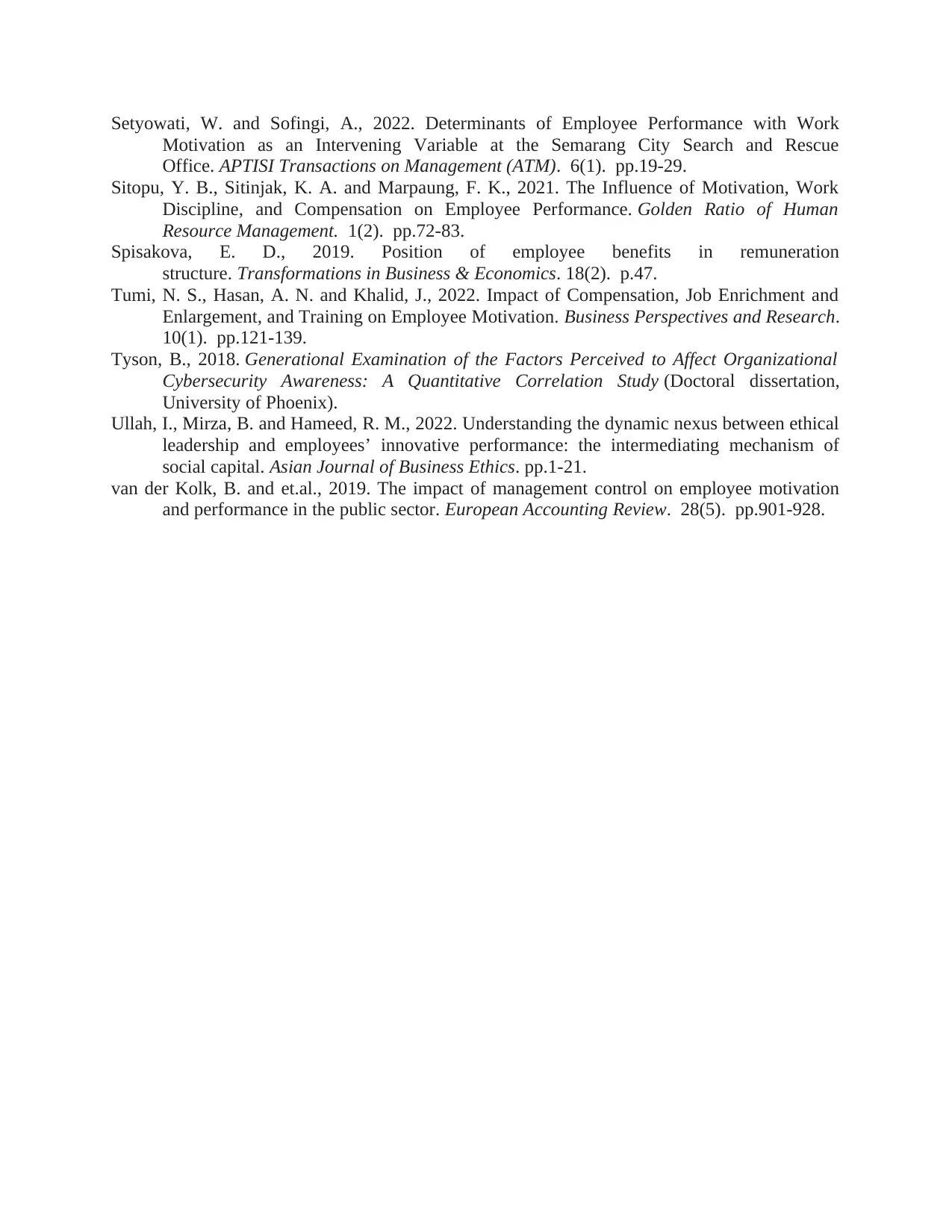
Setyowati, W. and Sofingi, A., 2022. Determinants of Employee Performance with Work
Motivation as an Intervening Variable at the Semarang City Search and Rescue
Office. APTISI Transactions on Management (ATM). 6(1). pp.19-29.
Sitopu, Y. B., Sitinjak, K. A. and Marpaung, F. K., 2021. The Influence of Motivation, Work
Discipline, and Compensation on Employee Performance. Golden Ratio of Human
Resource Management. 1(2). pp.72-83.
Spisakova, E. D., 2019. Position of employee benefits in remuneration
structure. Transformations in Business & Economics. 18(2). p.47.
Tumi, N. S., Hasan, A. N. and Khalid, J., 2022. Impact of Compensation, Job Enrichment and
Enlargement, and Training on Employee Motivation. Business Perspectives and Research.
10(1). pp.121-139.
Tyson, B., 2018. Generational Examination of the Factors Perceived to Affect Organizational
Cybersecurity Awareness: A Quantitative Correlation Study (Doctoral dissertation,
University of Phoenix).
Ullah, I., Mirza, B. and Hameed, R. M., 2022. Understanding the dynamic nexus between ethical
leadership and employees’ innovative performance: the intermediating mechanism of
social capital. Asian Journal of Business Ethics. pp.1-21.
van der Kolk, B. and et.al., 2019. The impact of management control on employee motivation
and performance in the public sector. European Accounting Review. 28(5). pp.901-928.
Motivation as an Intervening Variable at the Semarang City Search and Rescue
Office. APTISI Transactions on Management (ATM). 6(1). pp.19-29.
Sitopu, Y. B., Sitinjak, K. A. and Marpaung, F. K., 2021. The Influence of Motivation, Work
Discipline, and Compensation on Employee Performance. Golden Ratio of Human
Resource Management. 1(2). pp.72-83.
Spisakova, E. D., 2019. Position of employee benefits in remuneration
structure. Transformations in Business & Economics. 18(2). p.47.
Tumi, N. S., Hasan, A. N. and Khalid, J., 2022. Impact of Compensation, Job Enrichment and
Enlargement, and Training on Employee Motivation. Business Perspectives and Research.
10(1). pp.121-139.
Tyson, B., 2018. Generational Examination of the Factors Perceived to Affect Organizational
Cybersecurity Awareness: A Quantitative Correlation Study (Doctoral dissertation,
University of Phoenix).
Ullah, I., Mirza, B. and Hameed, R. M., 2022. Understanding the dynamic nexus between ethical
leadership and employees’ innovative performance: the intermediating mechanism of
social capital. Asian Journal of Business Ethics. pp.1-21.
van der Kolk, B. and et.al., 2019. The impact of management control on employee motivation
and performance in the public sector. European Accounting Review. 28(5). pp.901-928.
1 out of 12
Related Documents
Your All-in-One AI-Powered Toolkit for Academic Success.
+13062052269
info@desklib.com
Available 24*7 on WhatsApp / Email
![[object Object]](/_next/static/media/star-bottom.7253800d.svg)
Unlock your academic potential
© 2024 | Zucol Services PVT LTD | All rights reserved.




